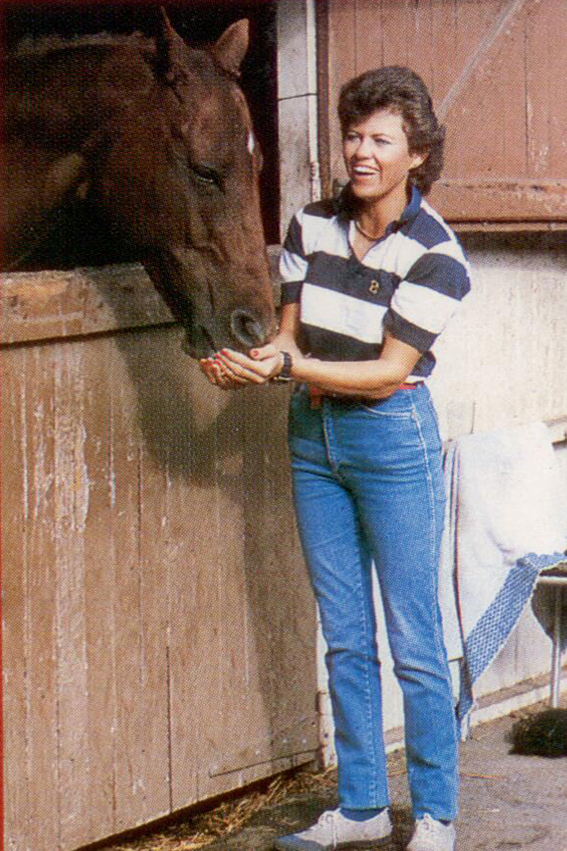 Colleen Brook has a directness that could easily be mistaken for toughness… if it were not for a smile that flashes on with speed and dazzling warmth. For all her awesome professionalism, Colleen is a very warm and natural person with a captivating respect and love for her horses…
Colleen Brook has a directness that could easily be mistaken for toughness… if it were not for a smile that flashes on with speed and dazzling warmth. For all her awesome professionalism, Colleen is a very warm and natural person with a captivating respect and love for her horses…
Like so many top riders, Colleen’s involvement with her horses came about through her mother’s enthusiasm. “She was a very keen horselady and she used to compete in all the local shows – gather all the horses in the district that were available to be ridden and take them off to the two or three shows we had a year. It was from her that my love of horses started. My father, he is a farm boy as well, but I don’t think he was as keen on horses as what mother was.”
We were brought up in Ballengin, near Coff’s Harbour, and we moved to Sydney about twenty years ago. I rode quite a lot and when we came to Sydney rode at Ryde Pony Club. I think jumping was always my first love. I did everything else with as much enthusiasm but when I was about sixteen or seventeen, showjumping became my number one.”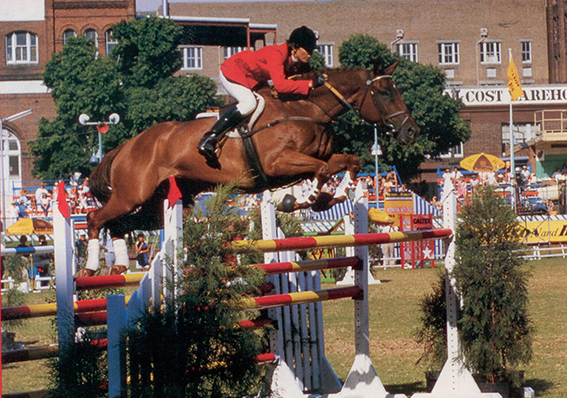
Why showjumping?
“When the Mexico Olympic Games were on and a couple of horses were drowned in the Three Day Event, it really upset me greatly. And I thought if I spent that long getting a horse ready and then to have it drowned or hurt in a mishap, that would be too much. Even though I did a lot of one-day eventing it put me off eventing for some years. I did quite a lot of dressage as well, but I found that too boring.”
And did you start out with a rough and ready Aussie showjumping style?
“I don’t think so. I started taking lessons early as a teenager. I was a member of a club – Gosh, there’s some famous members of it now – riders like Vicky Roycroft – it was a club for riders who were interested in more than just trotting round in circles, I think that really helped get me started. That was with Doug Green and Karl Jurenak.
“I asked my mother quite recently why I wanted to learn to ride like that – why didn’t I go on kicking and jerking like everyone else – and she said ‘I don’t know, that’s just how you decided you wanted to do it, and we helped you.”
Were you lucky with the horses you had?
“I don’t know if I had really super horses but they were pretty solid performers. I had Trooper, an all round horse that I had from when I was eleven until I was out of juniors – and he won One Day Events, Showjumping and Dressage. He was just a wonderful all round horse. The next one I had was Konrad, he was the same thing only he was Senior league. I won a State Championship on him, eventing – I won a State Eventing Championship on Trooper… I could never win a showjumping championship!”
“I have had some good horses. One of my first top showjumpers was Cinnabar, he was an A grade horse when we bought him, and he was a dear old fellow. He dumped me on the turf a few times, and told me what it was all about. Then Donauquelle, he was well above average. And of course there is the horse I am riding now, Rebound, he has to be one of the best I’ve known.”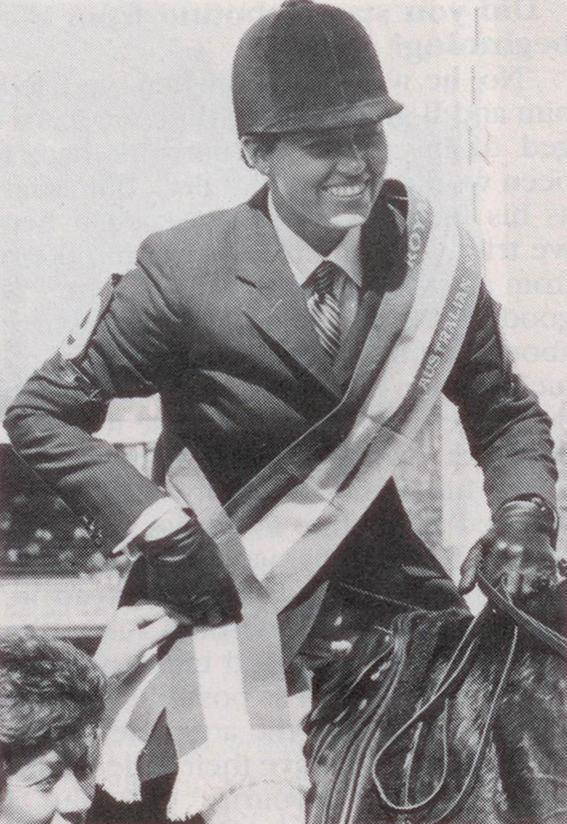
Fairly early, Colleen took the bold move of taking a horse to Europe…
“I took a horse called Harvey Bay. He was only a B grader here, he had never competed at a Royal Show, but he was a big horse with a big jump and I had a
Scottish girl who was helping me at the time, and she convinced me that I should go overseas and I’m really glad she did. Boy, what an eye-opener it was!”
“It was fantastic. Being exposed to all the tops in the Showjumping world was just marvelous. To be able to watch Harvey Smith and David Broome and Schockemohle … it was marvelous, and hopefully I learned a bit from that first trip and was even more determined to go back the second time.”
“It took me four years, but I eventually got there again.”
Did you change your style a lot after that first trip?
“Not greatly because all the basics were fairly well grounded. I had been going to Karl for some years doing dressage and showjumping, so my style was fairly well set. There were just a few subtle differences, that suited me, that I thought might work. Probably if Karl saw me ride today, it wouldn’t be the same rider, but everything about the position is basically the same. A lot is in the head, and I suppose I’m more American in my approach.”
In what areas?
“Mainly in the psychological attitude towards schooling their horses. Trouble is we don’t get to talk to them enough, so I read as much as I can, and look at their photographs, and try to pick up as much as I can. I think their philosophy of horse training is great, and as everyone has been saying, they suit our thoroughbreds – although they ride warmbloods too and do a very good job with them.”
“The whole American way of life is based on the idea that you’ve got to get into the mind. They just apply that to their animals. The LA. Games just proves that they were far and away the best.”
“The Americans manage to produce a horse that is disciplined while still being himself… disciplined, without being machine like. You seem to need freaky horses for top showjumpers these days, and the Americans seem to let that freaky horse be himself, but still be an obedient, disciplined showjumper.”
“Over the years I’ve picked up European ideas, and the Americans have moulded into that, and I’ve adapted it all Australian style… that’s probably how it has all come out. I find that my work program for the week has changed considerably over the past few years. I never used to allow anybody to ride my horses, not a person. But now I allow the grooms to hack the horses out… not only is it time-saving but I think it helps the horse when I get on. I pressure them a lot and ask them things. When they are out hacking and I’m not riding them, they relax and have a freer time. It’s not detrimental to their schooling – it doesn’t seem to influence them the next day when you ride them, their responsiveness is the same. But no-body rides the horses schooling, except me.”
“I think the Americans get their horses cantering much earlier over fences, than maybe the Europeans. Putting the rails down and cantering around the course, that’s very American. It’s wonderful for young horses and riders. No jumps, just the wings and the rail. It seems to really help the horses enormously, and they do that sort of thing much earlier than we do.”
“I mightn’t canter a young horse into a fence for some time because you have to help them too much, you set them up, and right from the beginning you are telling the young horse – ‘Don’t worry about it, I’m looking after you’ – and you are not supposed to do that. That’s where the Americans have a different attitude, they canter them over rails and mini courses, they don’t jump high, but they get everything operating very successfully over a three foot fence before they do anything more. We’re more inclined to feel that if they can jump three feet, let’s put the fence up another foot and see what they can do. They probably do put them up to try a horse out – I think you have to – but to school them they go back to the smaller fences and are very thorough with their basic work.”
“They don’t seem to worry whether they are fiery or quiet, they seem to just ask quietly and persistently. One be subtle about what you are asking them to do. It’s a difficult transition to ask subtly and keep asking until you get what you want. There’s a very thin line between being too sharp and quietly persisting. Quietly persisting you often feel like you are not getting anywhere… then you are tempted to push too hard.”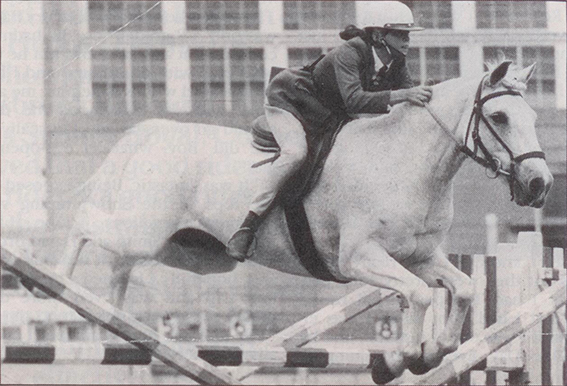
Colleen and Trooper – her first good horse
Did you start Rebound from the beginning?
“No, he was C grade when we tried him and B grade by the time we managed to buy him. His flatwork hadn’t been worked on a great deal, but as far as his jumping was concerned, when we tried him out, he could jump them from anywhere – so I thought, if he’s as good as I think he is, I won’t worry about whether his head is tucked in nicely when he canters about. If he can do it like that – good, because with the flatwork I can give him, it will only improve his manoeuvrability. I’ve never worried about him in a class. At home on the flat and before a class, I don’t consciously try and keep his head in, but I ride him in that fashion. I ride him very much forward and try to get him on the bit as much as possible because when you go into the arena he comes up a bit. They all have their little habits, but that’s his favourite one. But I forgive him a little for that, but I make sure he doesn’t do it on the flat. He’s not allowed to go with his head stuck out at home!”
How much flatwork do you give a top showjumper?
“It’s debatable, I find that if I give Rebound two days in a row, that is sufficient, three days and he says – ‘Oh oh no, I’ve had enough of this’. So off he goes out hacking. I think it varies with each horse, but I don’t often give them more than two days in a row. Or two days in the week between jumping. That doesn’t sound very much flatwork, but the hardest thing with show-jumpers is keeping them mentally fresh. They go to shows every weekend and they jump and jump and jump, if when they come home you are at them all week, they get fed up with it after a while.”
“I try to keep my fellow as mentally fresh as possible, and hacking out seems to help in that way, and it helps to keep them fit.”
“Keeping them mentally fresh and their muscle in tone seems to be the most important thing. They don’t need much jumping at that stage. You have to keep reminding them of their flatwork, but I don’t hassle them too much.”
You don’t remind them of their flatwork when you are out hacking?
”Yes and no. If I ride them out hacking I have to be very careful I don’t hassle them. I find it very difficult to get on a horse and just ride it. If they start swinging their quarters out, or do something, I think – ‘You’re not supposed to do that’ – and I go to do something, then I think – ‘No, no I won’t’. They need that little break from it. They need that little break from everything. When they go out they don’t have any rings or nosebands or anything – no restraint on them.”
With a young horse at home, one that you have started yourself, how long before he gets to see a competition?
“However long it takes for me to feel right about taking him out. I try not to put a set time on it. Some take longer than others, some are a bit surprising, they go ahead in leaps and bounds, then when you think they are ready to go somewhere, they fall in a heap, mentally. I try not to put a time limit on it. When I take them out, I want them to have good memories. I’d be devastated if I took a young horse out and he stopped once – anywhere! On the course, at the practice fence, anywhere – I’d be devastated! So I might be a bit slower at bringing them out than others, but when I bring them out, I like them to go sweetly and be fairly keen to get on and do the job properly.”
“Someone asked me once, ‘Do you have a lot of problems when you first take them to shows, do they play up?’. And I said, ‘I usually manage to have an argument with them well before I take them anywhere. I’m sure they are not machines, when they first go out they stand on their ears, but as far as their performance is concerned, I won’t take a young horse out until I am happy that he is going to do the right thing.”
“I’ve ridden some others, mind you, that don’t belong to me… and I wished I’d never. I wonder how people ever get them round the course. Gosh. I’m surprised how some people can manage to ride their horses. And people who aren’t very effective riders! Horses that don’t want to go, and they won’t turn and they don’t stop. They say – ‘Ah, I’m having a bit of trouble with…’ I think, ‘no wonder, you can’t ride him!”
So do you keep your horses so that you can place them without ruining their initiative?
“Whooh, that’s a hard one. I think because I always ride with the same system. I ride always with the hand and the leg together. I have a young mare that has just been broken in, and I ride that around the outside of the arena, and it wants to lug off back towards home – and I ride that with exactly the same system, my outside leg on to drive it forward, and I lead it with the inside rein. I support with the outside rein and the inside leg. I don’t expect anything wondrous from this young mare, but I want her to go forward and steady to my hand. It’s going with its nose right out and down, but after three days she is going forward and straight. With the older horses, I just do the same, but I increase the collection.
George Sanna and I spend a lot of time talking about the technicalities and we agree on the same thing – you must ride them forward into your hand. Forward and straight – and use your outside leg to your inside hand and your inside leg to the outside hand. Sure you’ll get the escapees who want to fall in, but if you ride in the same system all the time, you’ll get the result.”
“People say you must ride each horse to suit him individually – sure you do that because the pressure you use on one, you don’t apply to the other – but you use the same system. You can get on – it happens in schools regularly – get on the horse that is going abominably and in five minutes, the horse is going properly. The best way of riding is the best way because it doesn’t require brute strength, but you’ve got the horse where you want him immediately. If he goes to fall out, or he goes to fall in, those little aids just say – ‘Oh, oh, you can’t do it like that, you’ve got to do it like this’. And that’s why you can get on any horse and get a result. It so simple and so effective.”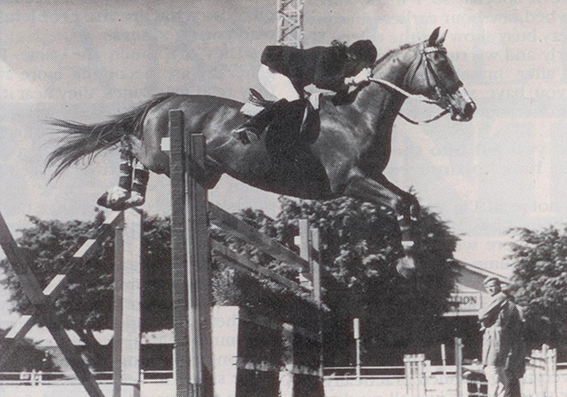
How not to jump – Colleen and Konrad. Colleen comments: ‘The horse’s neck is too high so his back is flat. The rider is leaning over looking down with no contact with the leg, only with the knees. ‘ After lessons with Karl De Jurenak this horse was educated to jump much softer and round himself over the jumps
Do you think that it’s possible to get so obsessed with technique that you lose that element of lunacy that is necessary to do the impossible things and win the really big showjumping contests?
“I’m sure you can. I’m sure I did for a while because I was in search of perfection.
It didn’t hurt me in the long run because I’ve at least been there and I know what it is like. But you can go too much the other way and be too lunatic. I think if you want to be good at anything you have to be well disciplined, but you have to have that degree of flair which makes you the little bit better… and that goes for the horse as well.”
Do you use mental rehearsal techniques to improve performance?
“Not really – I think concentration is the key. Those rehearsal programs, they help the less experienced riders cope with stress. I’m possibly into the more experienced rider classification, and that has taught me how to cope with stress. If I was to start on one of those programs now, then possibly it wouldn’t have the impact that it would have had on me ten years ago. It probably would have helped me greatly then.”
“Concentration is the key, and when I am teaching, that’s what I try to get out of my pupils. Teach yourself to concentrate, and discipline yourself. Because if you can’t discipline yourself, you cannot discipline the horse… I don’t mean hitting him, I mean getting him obedient.”
You were saying how hard it is to keep the showjumping horse mentally fresh – how hard is it to keep the rider fresh going round all those shows?
“When you are in it week in week out, you have to bury yourself in it a little bit, to make sure that you concentrate, but the periods of relaxation are very important. I play tennis, and I play the piano. If I am relaxing I always do active things, I’m not one for sitting around – mind you I love sleeping – but I have to be doing something. You’ve just got to make sure you get your relaxation time between shows.”
For a big show like Benson & Hedges with a lot more prizemoney and a lot more atmosphere – do you approach that show differently?
“Yes. We look forward to it every year. As far as I can say, it’s the biggest and the best showjumping show in Australia. The international riders really make it special, so I made sure I went to bed one hour earlier – because it is a very busy show for the riders. We start early and we run all day, so I just looked after myself that bit better. When you have very reliable people working for you, like I have, it really helps.”
When you got into the jump-off, did you have to tune yourself up again?
“No – not at all. I’m astounded when I think about how I concentrated for that class. There were two young fellows in the jump off, and there was never any doubt in my mind that I could go as fast – and leaving them up was not even a consideration. I don’t know if I felt the horse was really on the job, but I didn’t even think about it. I had everything planned practically to a canter stride and it just all worked. I was just a bit dumbfounded that I managed to do it as I planned. I didn’t really plan to start so steadily, but I had a good rhythm coming to the first and I thought if I up this rhythm going round the corner I might do this, and I might do that, so I’ll just leave it at that, because I knew he could cut it really short. And it just worked! It was great – wish I could do it every week!”
What’s in the future for Colleen Brook?
“I think we’ll go off to Perth this year. The World Cup – this next time, that would be great. It is a bit of a drain on our top horses, the World Cup, it’s a good competition, but it’s losing two top horses to Europe every time… it takes a long time for them to reacclimatise when they come home. They jump and they go round shows, but they don’t hit the same form for some time. The World Championships have to be on everybody’s mind … that would be the immediate ambition.”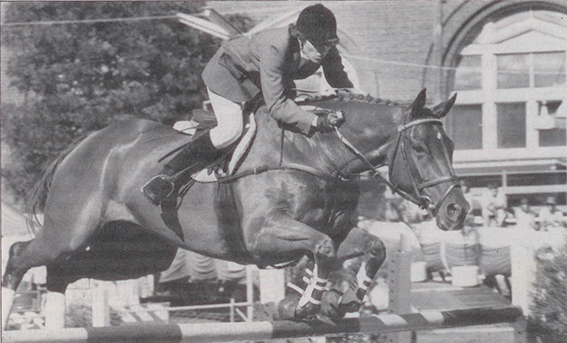
Colleen and Rebound win at Benson and Hedges
You do a lot of schools and clinics – what are the problems with our young riders?
“They are much the same. People generally are becoming more aware – they read magazines, they hear it said a lot – but the problems are still very similar. Too much hand, not enough leg, and not enough emphasis on getting their position effective, and getting the horse going sweetly. There are some riders that I see that change bits every week on their horse. The horse won’t do this, and the horse won’t do that … And that’s not the reason. Don’t blame the horse- you must ride through the problems and work out what they are.”
“There are traps. You can give away too much rein in the air, and then be too long collecting the horse up on the other side. I’m very critical of my own riding and every photograph I get, I go over it with a fine tooth comb. If I see a succession of photographs that I’m not happy with, then there’s obviously something going wrong, and I’ll try to discuss it with somebody. George Sanna, Rod Brown, Vicky and Wayne Roycroft – we see each other regularly so we’ll get together and have a good old yarn about things. We often discuss each others problems.”
Do you have a pattern of faults that you fall into?
“I’ve probably done them all, and continue to do so, but in more subtle ways. I think it probably all stems from our upbringing as Australians. All the American riders that you see have that style. I’d like to see more of that style, but without us losing our Australian way of thinking. That’s very important… because we don’t think like Americans. I certainly wouldn’t like us to become too Americanised in our way of thinking, and lose ourselves. But we could certainly do with more style.”
Is showjumping a business or a pleasure?
“I still do it because I love horses. I wouldn’t do it for any other reason – because if you are searching for fame and glory it’s a long search! Money couldn’t ever be the only reason you ride horses, because the energy, the time, the heartbreak, the mental torture, you put yourself through, to get out and do what you want to do on a horse. There is absolutely no money in the world that could make up for that. It’s the love of horses and the thrill of jumping that I like. Good horses help. I could nearly say that every horse we have is a nice horse. There’s very few rotters amongst them. They are generally a good bunch. They all have their own characters of course. Some are steady, some are a bit erratic, but generally, they are nice enough fellows. It makes it all worthwhile.”
This article first appeared in the June 1985 issue of THM.
